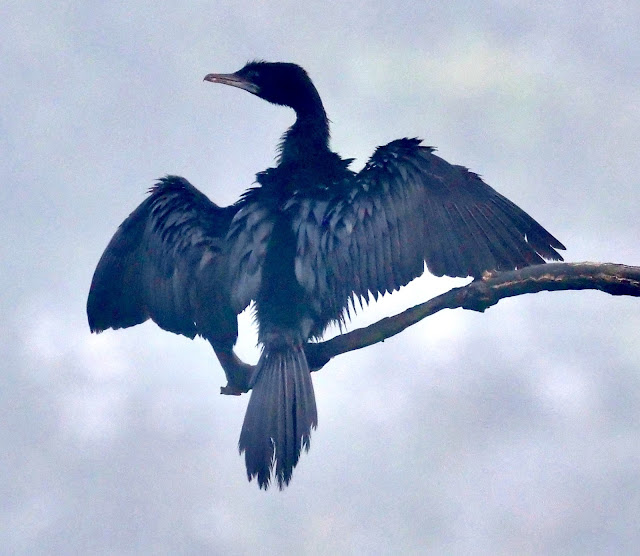On a misty morning, I walked in to the garden, for the pleasure of getting a feel of how plants looked when the distant visibility was poor.
A movement of foliage in a nutmeg tree, with a few of its branches bare, were just visible in the cloudy morning.
I spotted a Cormorant after a long spell of absence from our garden. With the visibility poor, I was not sure if it was an Indian Cormorant or a little Cormorant.
I watched its movements through the tele-lens, seeing it move from one branch with some foliage to another branch, fully bare stretching horizontally farther away from the stem. It was there it stayed for about fifteen minutes, grooming and drying its wings. The fully stretched wet wings did indicate that it was perched after a fish meal from the stream beside the nutmeg grove.
It had an alert look with neck turning in all directions, which occupied my attention, till it flew away beyond visibility in that misty morning.
I do look out in this site regularly as it is a favourite site for Kingfishers to watch the stream below.
Two thoughts crossed my mind. The Cormorants feed exclusively on fish. That involves covering long distances between water bodies. As they immerse themselves in water while catching fish, it would need to dry its body before immersing in water another time. The glistening plumage is a sign of the attention it pays to be flight ready and ready to dip into water. How it adapts to the needs and the opportunity!
Our domestic worker is a person who is quick to respond and often seems to be in a hurry to complete a job. He does whatever he does neatly, although he seems to be in a hurry. During the last two weeks, we were engaged in the painting the cottage, which involved slow and careful strokes to make the painting a decorative work. I was amazed to see him do that job with diligence and attention. He, having been a mason by training and experience, he has mindset for planning. It was great to watch him to give a first coat and do painting of another surface till the earlier surface is dry for a second coat of paint.
The Cormorant is an alert and vigilant water bird. It follows an orderly fashion. Even the nest it makes, which I found near a waterbody while on a picnic, suggests how there is a structure and design for their nest.
Someone recently asked me if I spend a lot of time watching birds. It is about an hour on most days between the morning and evening. I find this exercise contributing to my skills of observation, patience and alertness. The bird calls of some birds like Bulbuls have become familiar to me to get a sense of the different tones and pitch they use to convey messages to each other.
I feel most fascinated by the behaviour of Bulbuls at the feeding station. Usually one or two birds arrive for the feed early in the morning. They make special bird calls which bring more Bulbuls to the feeding bowl. In fact those who arrive first wait for others to come before they start feeding. Those who had few helpings of food, would move away to perch in the tree, allowing more birds to feed from the bowl. They are not solitary feeders, but seem to favour feeding together with other birds. The gregarious feeding habit of Barbets is in contrast to this. The Barbets alone take large bites of food and fly away to a nearby perch to feed privately.
I watched a video of a watchman who received his food packet after finishing his work at a hotel and carrying the food packet home to share the meal with his wife and his cat. An amazing sense of attachment to his spouse!
How birds, others, stories we read or hear leave impressions to make us more thoughtful, caring and observant of goodness that abides in others around us.
Dulcie and Daphne remind us of some good practices. They come to be stroked and talked to. They indicate when they need a treat of biscuit by their nudging look! Anna while feeding the fish, stand before the Acquarium. The fish move upwards and wait for feed to be dropped. They recognise Anna's presence at the feeding time.
I realise how birds and our pets bring us to be more relational from our pre-occupied state! Dulcie knowing when we are about to go out, when we change dress, would come close to us wanting to be stroked and spoken to! When it is lightning and thundering she comes to close to us and wants to be comforted. She is most comfortable if she finds a place in our lap. That is how she expresses her emotional needs.
These were my thoughts after watching the Cormorant in the garden! It was a messenger to remind me about soft social skills that need more attention!
M.C.Mathew(text and photo)








No comments:
Post a Comment